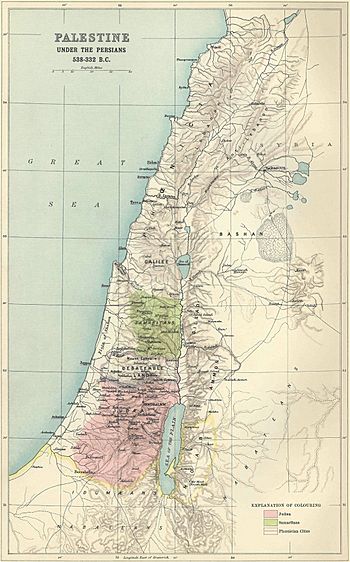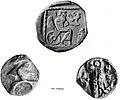Yehud Medinata facts for kids
Quick facts for kids
Yehud State
Yehud Medinata |
|||||||||
|---|---|---|---|---|---|---|---|---|---|
| c. 539 BCE–c. 332 BCE | |||||||||

Yehud Medinata (in pink) under the Persian Empire
|
|||||||||
| Status | Province of the Achaemenid Empire | ||||||||
| Capital | Jerusalem 31°47′N 35°13′E / 31.783°N 35.217°E |
||||||||
| Common languages | Aramaic, Hebrew, Old Persian | ||||||||
| Religion | Second Temple Judaism | ||||||||
| History | |||||||||
| c. 539 BCE | |||||||||
|
• Wars of Alexander the Great
|
c. 332 BCE | ||||||||
| Currency | Daric, siglos | ||||||||
|
|||||||||
| Today part of | |||||||||
Yehud Medinata, also called Yehud, was an important area that was part of the powerful Persian Empire. Its name means 'the State of Judah' in the Aramaic language. It was located within a larger Persian region called Eber-Nari.
This area was similar to the older Kingdom of Judah, but it was smaller. Yehud Medinata covered roughly the same land as the earlier Babylonian province of Yehud. This Babylonian province was created after the Neo-Babylonian Empire took over the Kingdom of Judah around 597 BCE.
Yehud Medinata existed for about 200 years. It became part of Alexander the Great's empire when he conquered the region.
Contents
A Look Back: The History of Yehud
The exact dates for when the Babylonians and Persians ruled can be a bit tricky. Historians sometimes have slightly different ideas about the precise years. Here are some key events that shaped Yehud Medinata:
From Babylonian Rule to Persian Control
- 587 BCE: The city of Jerusalem was conquered by the Babylonians. Many people were forced to leave their homes and move to Babylon. This was the second time this happened. A leader named Gedaliah was put in charge in Mizpah.
- 582 BCE: Gedaliah was killed. Because of this, many people fled to Egypt. More people were sent away to Babylon.
- 562 BCE: Jeconiah, who was the king of Judah, had been taken to Babylon in 597 BCE. He was finally set free, but he stayed in Babylon.
- 539 BCE: A powerful ruler named Cyrus the Great conquered Babylon. This was a huge change for the region.
- 538 BCE: Cyrus made a special announcement. It allowed the Jewish people who had been forced to leave to return to Jerusalem. This was a very important moment for them.
Rebuilding and New Beginnings
- 530 BCE: Cyrus's son, Cambyses II, became the new ruler of the Persian Empire.
- 525 BCE: Cambyses conquered Egypt, making the Persian Empire even larger.
- 522 BCE: Darius I became the next Persian king.
- 521 BCE: Darius had discussions with the Jewish people who were still in Babylon.
- 520 BCE: Zerubbabel returned to Jerusalem as the governor of Yehud. Joshua came back as the High Priest.
- 520-515 BCE: This was a busy time! The Jewish people began to rebuild their main temple in Jerusalem. This new temple is known as the Second Temple.
- 458 BCE: A religious leader named Ezra arrived in Jerusalem. This happened during the rule of King Artaxerxes I.
- 445/444 BCE: Nehemiah also arrived in Jerusalem. He played a big role in rebuilding the city's walls.
The End of Persian Rule
- 333/332 BCE: Alexander the Great conquered the Mediterranean parts of the Persian Empire. This marked the end of Persian rule over Yehud. It also started a new period called the Hellenistic age, where Greek culture became very important.
Related pages
Images for kids
See also
 In Spanish: Yehud Medinata para niños
In Spanish: Yehud Medinata para niños





